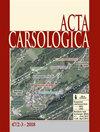综合地球物理方法研究岩溶塌陷——以广州市从化区为例
IF 1.1
4区 地球科学
Q4 GEOSCIENCES, MULTIDISCIPLINARY
引用次数: 4
摘要
采用综合地球物理方法对广州市从化区坳头岩溶塌陷的地质条件进行了研究。基于音频大地电磁(AMT)测深、高密度电信号和微震,在三维空间中从浅层到深层探测到土壤结构与厚度、断层、隐伏岩溶等一系列特征。然后将这些数据与地质和钻井数据进行比较。微振动和高密度电信号测量表明,崩塌区地层由粘土和中粒砂组成,厚度约为8 ~ 15 m,呈多元结构。AMT探测在地下发现了一个隐藏的结构,它位于向斜的核心,靠近可溶石灰岩和不可溶花岗岩之间的接触带。结合地质资料,高密度电法测量还表明,研究区发育下石炭统大唐期石灯子组,含碳质泥晶岩和白云质灰岩,局部穿插薄石英粉砂岩,岩溶发育。土壤结构、地下隐伏结构和岩溶发育为塌陷提供了首要条件。岩溶塌陷的主要触发因素是地下水位的季节变化和地下水的过度开采。这些结果可为其他地质条件相似的地区研究该问题的地球物理方法的选择和应用提供指导。本文章由计算机程序翻译,如有差异,请以英文原文为准。
Investigation of karst collapses using integrated geophysical methods: an example from Conghua district, Guangzhou city, China
Integrated geophysical methods were used to investigate the geological conditions of karst collapses in Aotou, Conghua District, Guangzhou City. Based on audio frequency magnetotelluric (AMT) soundings, high-density electric signals and microtremors, a series of features, including the soil structure and thickness, faults, and hidden karst, were detected from shallow to deep subsurface regions in three-dimensional (3-D) space. These were then compared with geologic and drilling data. The measurements of micro-vibrations and high-density electric signals revealed that the strata in the collapsed area consists of clay and medium-grain sand, which is approximately 8–15 m thick and arranged as a multiple-element structure. The AMT soundings uncovered a hidden structure in the subsurface, which lies at the core of a syncline and adjacent to a contact zone between soluble limestone and non-soluble granite. Combined with the geologic data, the survey using the high-density electric method also showed that the study area hosts the Shidengzi Formation from the Datang Stage of the lower Carboniferous, which contain carbonaceous micrite and dolomitic limestone, locally intercalated with thin quartz siltstone, with well-developed karst. Collectively, the soil structure, hidden structure in the subsurface, and karst development provide the primary conditions for collapses. The main triggering factors for the karst collapses are seasonal variations in groundwater levels and excessive groundwater withdrawals. These results can provide guidance for the selection and application of geophysical methods for the examination of this issue in other areas with similar geology.
求助全文
通过发布文献求助,成功后即可免费获取论文全文。
去求助
来源期刊

Acta Carsologica
地学-地球科学综合
CiteScore
1.50
自引率
14.30%
发文量
0
审稿时长
>12 weeks
期刊介绍:
Karst areas occupy 10-20 % of ice-free land. Dissolution of rock by natural waters has given rise to specific landscape and underground. Karst surface features and caves have attracted man''s curiosity since the dawn of humanity and have been a focus to scientific studies since more than half of millennia.
Acta Carsologica publishes original research papers and reviews, letters, essays and reports covering topics related to specific of karst areas. These comprise, but are not limited to karst geology, hydrology, and geomorphology, speleology, hydrogeology, biospeleology and history of karst science.
 求助内容:
求助内容: 应助结果提醒方式:
应助结果提醒方式:


